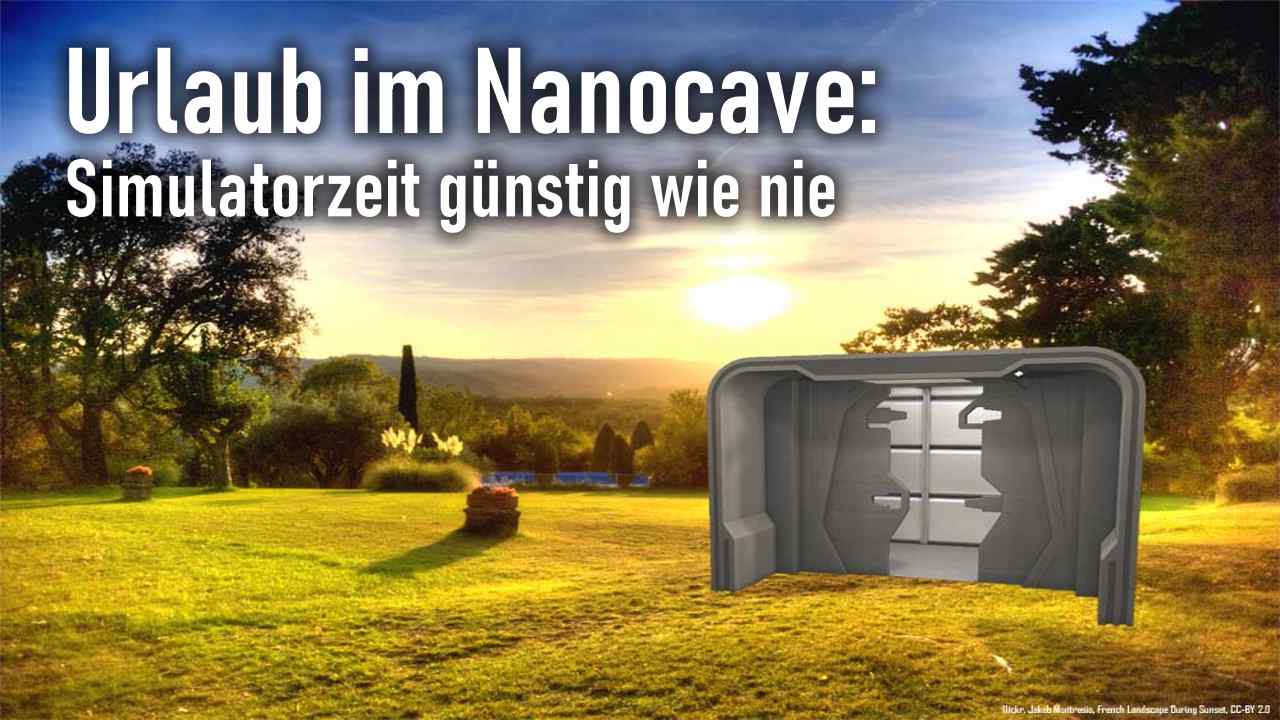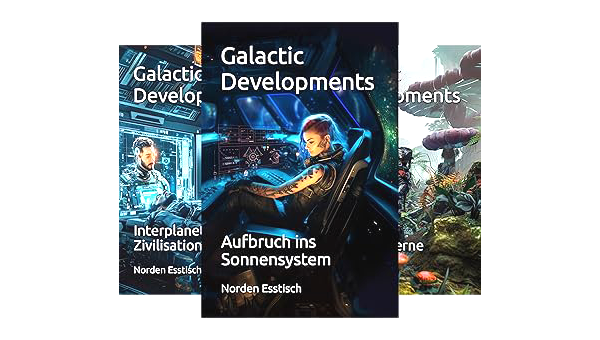
2844 Virtuelles Paradies entdeckt

Die Studenten E. Harris und S. Nunez entdecken den Centaurus-Komplex. Der Softwarekomplex läuft seit langer Zeit anonym im Solnet und wird beliebt als Ausflugsziel.
Der Centaurus-Simulationskomplex wurde per Zufall im Solnet, dem solaren Informationsverbund, entdeckt. Er umfasst eine Datenmenge von 85 PB; 15 PB im Interface, ca. 50 PB im Kern und 20 PB Utilities, darunter mindestens vier verschiedene nicht bewusste KIs. Der Komplex ist größen- und inhaltsstabil. Die mittlere Datenaustauschrate beträgt nur 10 ppB pro Jahr, im Wesentlichen durch Statistik und automatische Optimierungen. Er ist wie viele andere Software-Komplexe delokalisiert mit 60% Aufenthaltswahrscheinlichkeit der Hauptmasse im irdischen Geosyncbackbone. Der Gesamt-IO war in der Vergangenheit vernachlässigbar, steigt in jüngster Zeit aber deutlich an.
Die Hauptfunktion des Komplexes ist die physikalische Simulation eines (für Menschen idyllischen) Kontinents auf Eon im Vocon-Cluster. Die Simulation ist sehr detailliert, so dass der durchschnittliche Benutzer mit einem modernen Rig keine Inkonsistenzen sehen sollte. Der ursprüngliche Zweck scheint eine wissenschaftliche Biosphärensimulation zu sein. Darauf deuten die alten Logs hin. In den Logs erscheinen die Beschreibungen sehr vieler Simulationsläufe und Restarts mit jeweils leicht variierenden Anfangsbedingungen. Deutlich sind Forschungsreihen zu erkennen in denen Wissenschaftler von Vocon den Einfluss von Umwelteffekten auf die Biosphäre untersuchten. Die einzelnen Personen sind heute nicht mehr zu identifizieren. Für genaue Nachforschungen ist der Vocon-Cluster aber auch zu weit entfernt und der Komplex zu alt.
Die im Vergleich zur Funktionsvielfalt und Detailtreue geringe Größe des Centaurus-Komplexes spricht für einen hohen Entwicklungsstand der Informationsverarbeitung. Die Blindleistung des Simulatorkerns wird auf weniger als 30% geschätzt; bei weniger als 5% Transferverlusten. Die Implementierung ist sehr flexibel. Sie läuft im öffentlichen Solnet auf moderner Quantenhardware und sogar – mittels einer eigenen KI – auch im alten Nukleonenarrayverbund, der im Tara Computing History Museum immer noch als Simulation betrieben wird. Untersuchungen verschiedener Kernsysteme zeigen sehr effiziente Algorithmen. Einer der Objectcores wurde sogar in das irdische Wettersystem übernommen. Dies geschah allerdings erst nach Ablauf der Sperrfrist, die den Entdeckern für 20 Jahre die Exklusivrechte zusicherte.
Der Komplex verfügt über keinerlei herausgehobene Ausführungsprivilegien. Er läuft selbständig nur mit einem schmalen Wartungsflow, der sehr wenig Leistung beansprucht. Der Komplex lebte deshalb unauffällig mit Myriaden anderen Low-Priority Prozessen in Solnet und wird über öffentliche Budgets unterhalten. Bei aktiver Benutzung wird der Eingangsbereich semistatisch erzeugt über die persönliche Visualisierung des Benutzers. Interfaces zu Nano-Caves sind verfügbar. Es gibt eine breite Palette von Standardszenen, die von den meisten Visualisierungen interpretiert werden können. Im Normalfall wird der Simulatorkern nicht benötigt. Die Standardszenen sind flexibel genug, um individuelle Szenen ohne Vollsimulation zu ermöglichen. Dadurch ist der Zugang sehr günstig. Dies ist ein wesentlicher Grund, dass der Centaurus-Komplex als Ausflugsziel immer beliebter wird. Neben der fast perfekten Darstellung einer bezaubernden Landschaft ist es vor allem der günstige Zugang auch für kurze Runs, der immer mehr Leute anzieht. Obwohl Nano-Visualisierung wegen der Cavezeit nicht so günstig ist, wie 3D, wird auch der Zugang über das Nano-Interface immer häufiger benutzt. Vor allem die Nano-Darstellung überzeugt durch detailreiche, aber ressourcenschonende Implementierung. Eine normale 2-Personen Szene im 500er Cave (500 Kubikmeter) degradiert den Cave-Fog nur um ein Prozent pro Stunde.
Wie ein so hochentwickeltes Simulationspaket der Vocon Zivilisation in das Solnet gelangte, ist weiterhin ungeklärt. Nachforschungen haben ergeben, dass es erstmals 2764 in Backups auftaucht. Traces, die über die ersten Transaktionen Aufschluss geben könnten, sind vermutlich bei der Solnet Kompaktifizierung 2824 gelöscht worden. Es konnte keine Eigentumszuordnung gefunden werden, weder im Komplex noch in Solnet-Beständen. Die einzige externe Zuordnung mit Kontakteigenschaften im Solnet ist intern ungültig. Centaurus ist nach neuesten Erkenntnissen ein TSNH-Fall (This Should Never Happen). Seine Entdeckung löste ein aufwändiges systemweites Remapping referenzieller Gruppenkennungen aus. Der Komplex lebte – und lebt immer noch – unter diversen wechselnden öffentlichen Identitäten, eine durchaus weit verbreitete Vorgehensweise. Vermutungen, dass der Komplex als Tarnung für einen Infiltrationsmechanismus dient, haben sich als haltlos erwiesen. Der Komplex wurde als unbedenklich eingestuft und hat in 150 Jahren öffentlichen Betriebs keine Auffälligkeiten gezeigt.
Der Centaurus-Komplex wurde von zwei Studenten entdeckt, die an einer Studie über Transformationsfluktuationen zweiter Ordnung in Backbone-Flows arbeiteten. Die Studenten, E. T. Harris (hartE) und S. Nunez (ce9kit) griffen nur zufällig Transaktionen von Centaurus heraus. Sie analysierten dann aber die Quelle und verschafften sich schließlich Zugang zum Komplex. Der Wartungszugang war nur schwach gesichert mit einer einfachen Passgeste, die mit Standardtools rekonstruiert werden konnte. Die Geste ähnelt dem Sternbild Centaurus, daher der Name des Komplexes. Nach dem Unclaimed Information Structure Act von 2800 wurde der Komplex nach 3-jähriger einspruchsfreier Offenlegungsfrist den beiden Entdeckern zugesprochen. 2869 wurde er dann öffentliches Eigentum unter Solnet Verwaltung. Die Wartungszugänge wurden geschlossen, um den Komplex vor Missbrauch zu schützen. Das Besuchertor bleibt weiterhin geöffnet.
Mehr Entdeckungen
2312 Kaio-Artefakt
2412 Pontos Mission
2493 Oumuamua
2501 Extraplanetare Forschung
2638 Gas-Wesen
2668 Ultrametalle
2681 Roboterzivilisation
2776 Höhlensysteme
2834 Generationsschiffe
2841 Leuchtender Tempel
2844 Digitale Entdeckung
2860 Deepspace-Grid
2870 Overlay KI Zivilisation
2873 Entdeckung im Weltraum
3042 Galaxien
3131 Roboter und Drachen
3270 12.000 Jahre Geschichte
3359 Survivalisten in Not
Neue Beiträge
2158 Space Patrol
2222 Weltraumpiraten
2326 Kein interplanetarer Krieg
3050 Königliche Garde
3090 Solo Ehre
2234 Am Ende des Orbits
2248 Gemini-Katastrophe
2366 Orbitale Ökonomie
2312 Kaio-Artefakt
3361 Erste Menschheit
2333 Metrische Impulsverstärkung
2337 Verschwörung im Orbit
2247 Quantensprung
2284 Trennung der Erde
2321 Isolation der Erde
2205 Unternehmensnationen
2192 Antiexpansionistischer Terror
2179 Private Asteroidenbasis
2231 Vereinte Planeten
2291 Verbotene Forschung
Die Besten
(20 von 75)
2135 Sonnenschirm für die Erde
2179 Private Asteroidenbasis
2231 Vereinte Planeten
2303 Raumhändler-Putsch
2333 Metrische Impulsverstärkung
2337 Verschwörung im Orbit
2469 500 Jahre Tranquility
2471 Krieg auf der Venus
2493 Oumuamua
2532 Panik im Sonnensystem
2544 Nachricht des Jahrhunderts
2668 Ultrametalle
2681 Roboterzivilisation
2722 Sein Leben für die Kinder
2725 Auch Maschinen haben ein Gewissen
2750 VR-Drama Executive Decision
2776 Höhlensysteme
2806 Weltraum Müll
2969 1000 Jahre Mondlandung
3296 Drachenlegenden
 2843
Gefährliche Bergung
2843
Gefährliche Bergung

 2845
Plünderung durch Neobarbaren
2845
Plünderung durch Neobarbaren